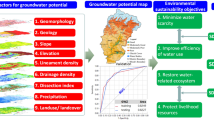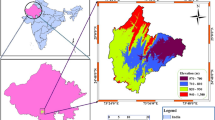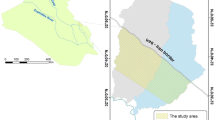Abstract
This study used remote sensing (RS) and geographic information system (GIS) techniques to assess groundwater potential areas by applying two multi-criteria decision-making analyses tools in the Arghandab river basin. Twelve influencing parameters summarizing basin characteristics were gathered and generated using geospatial RS and GIS tools. The analytical hierarchy process (AHP) and analytical network process (ANP) were examined to weigh, ranking, and reclassify raster to produce groundwater potential maps. Two multi-criteria decision models were applied to compare results and suitability in the study area. The results of the AHP analysis delineate five groundwater potential zones (GWPZs) classified as very poor (29%), poor (22%), moderate (17%), high (19%), and very high (14%). On the other hand, the results of the ANP analysis classified GWPZs as very poor (25%), poor (9%), moderate (25%), high (30%), and very high (11%). To validate generated GWPZs maps, a total of 270 well locations data were utilized in the receiver operating characteristic (ROC) curve analysis. ROC model accuracy in training and validation stages is marginally higher for the ANP model (0.810 and 0.823) as compared to the AHP model (0.749 and 0.742). The groundwater potential map delineated in this study offers a preliminary assessment to scientists, public authorities, and policy makers for sustainable management of groundwater resources in the study area.









Similar content being viewed by others
Data availability
The data that support the findings of this study are available from the corresponding author upon reasonable request.
References
Achu AL, Thomas J, Reghunath R (2020) Multi-criteria decision analysis for delineation of groundwater potential zones in a tropical river basin using remote sensing, GIS and analytical hierarchy process (AHP). Groundw Sustain Dev 10:100365. https://doi.org/10.1016/j.gsd.2020.100365
Agarwal E, Agarwal R, Garg RD, Garg PK (2013) Delineation of groundwater potential zone: an AHP/ANP approach. J Earth Syst Sci 122(3):887–898. https://doi.org/10.1007/2Fs12040-013-0309-8
Ahmadi H, Kaya OA, Babadagi E, Savas T, Pekkan E (2020) GIS-based groundwater potentiality mapping using AHP and FR models in central antalya. Turkey. Environ Sci Proc 5(1):11. https://doi.org/10.3390/IECG2020-08741
Alami MM, Din SW, Tayfur G (2018) Meteorological drought analysis by different methods in Helmand River Basin, Afghanistan. Int J Sci Eng Res 9(2):738–745. https://doi.org/10.14299/ijser.2018.02.004
Allafta H, Opp C, Patra S (2020) Identification of groundwater potential zones using remote sensing and GIS techniques: a case study of the Shatt Al-Arab Basin. Remote Sens 13(1):112. https://doi.org/10.3390/rs13010112
Arulbalaji P, Padmalal D, Sreelash K (2019) GIS and AHP techniques based delineation of groundwater potential zones: a case study from southern western ghats, India. Sci Rep 9:2082. https://doi.org/10.1038/s41598-019-38567-x
Arya S, Subramani T, Karunanidhi D (2020) Delineation of groundwater potential zones and recommendation of artificial recharge structures for augmentation of groundwater resources in Vattamalaikarai Basin. South India. Environ Earth Sci. 79:102. https://doi.org/10.1007/s12665-020-8832-9
Arefin R (2020) Groundwater potential zone identification at Plio-Pleistocene elevated tract, Bangladesh: AHP-GIS and remote sensing approach. Groundw Sustain Dev 10:100340. https://doi.org/10.1016/j.gsd.2020.100340
Ayenew T, Demlie M, Wohnlich S (2008) Application of numerical modeling for groundwater flow system analysis in the Akaki catchment, central Ethiopia. Math Geosci 40(8):887–906. https://doi.org/10.1007/s11004-008-9144-x
Benjmel K, Amraoui F, Boutaleb S, Ouchchen M, Tahiri A, Touab A (2020) Mapping of groundwater potential zones in crystalline terrain using remote sensing, GIS techniques, and multicriteria data analysis (case of the Ighrem Region, Western Anti-Atlas, Morocco). Water 12(2):471. https://doi.org/10.3390/w12020471
BGR (2003) Hydrogeology of the Kabul Basin part I: geology, aquifer characteristics, climate, and hydrograph. Hanover. Germany.
Brati MQ, Ishihara MI, Higashi O (2019) Groundwater level reduction and pollution in relation to household water management in Kabul, Afghanistan. Sustain Water Resour Manag 5(3):1315–1325. https://doi.org/10.1007/s40899-019-00312-7
Çelik R (2019) Evaluation of groundwater potential by GIS-based multicriteria decision making as a spatial prediction tool: case study in the Tigris River Batman-Hasankeyf Sub-Basin, Turkey. Water 11(12):2630. https://doi.org/10.3390/w11122630
Chenini I, Msaddek MH, Dlala M (2019) Hydrogeological characterization and aquifer recharge mapping for groundwater resources management using multicriteria analysis and numerical modeling: a case study from Tunisia. J Afr Earth Sci 154:59–69. https://doi.org/10.1016/j.jafrearsci.2019.02.031
Chowdhury A, Jha MK, Chowdary VM (2010) Delineation of groundwater recharge zones and identification of artificial recharge sites in West Medinipur district, West Bengal, using RS, GIS and MCDM techniques. Environ Earth Sci 59(6):1209–1222. https://doi.org/10.1007/s12665-009-0110-9
Chung S, Lee AHI, Pearn WL (2005) Analytic network process (ANP) approach for product mix planning in semiconductor fabricator. Int J Prod Econ 96:15–36
Dar T, Rai N, Bhat A (2020) Delineation of potential groundwater recharge zones using analytical hierarchy process (AHP). Geol Ecol Landsc. https://doi.org/10.1080/24749508.2020.1726562
Das B, Pal SC, Malik S, Chakrabortty R (2019) Modeling ground- water potential zones of Puruliya district, West Bengal, India using remote sensing and GIS techniques. Geol Ecol Landscapes 3(3):223–237. https://doi.org/10.1080/24749508.2018.1555740
Ebraheem AM, Garamoon HK, Riad S, Wycisk P, El Nasr AMS (2003) Numerical modeling of groundwater resource management options in the East Oweinat area, SW Egypt. Environ Geol 44(4):433–447. https://doi.org/10.1007/s00254-003-0778-1
Farahmand A, Hussaini MS, Zaryab A, Aqili SW (2021) Evaluation of hydrogeoethics approach for sustainable management of groundwater resources in the upper Kabul sub-basin, Afghanistan. Sustain Water Resour Manag 7(3):1–7. https://doi.org/10.1007/s40899-021-00525-9
Garewal SK, Vasudeo AD, Landge VS, Ghare AD (2015) A GIS-based Modified DRASTIC (ANP) method for assessment of groundwater vulnerability: a case study of Nagpur city, India. Water Qual Res J 52(2):121–135. https://doi.org/10.2166/wqrj.2017.046
Ghandehary A, Barati R (2018) River flow modeling by the application of remote sensing and fuzzy regression: progress in river engineering & hydraulic structures, chapter 7, pp 129–150
Goes BJM, Parajuli UN, Haq M, Wardlaw RB (2017) Karez (qanat) irrigation in the Helmand River Basin, Afghanistan: a vanishing indigenous legacy. Hydrogeol J 25(2):269–286. https://doi.org/10.1007/s10040-016-1490-z
Görener A (2012) Comparing AHP and ANP: an application of strategic decisions making in a manufacturing company. Int J Bus Soc Sci 3(11): 194–208. http://www.ijbssnet.com/journals/Vol_3_No_11_June_2012/22.pdf
Hajihosseini H, Hajihosseini M, Morid S, Delavar M, Booij MJ (2016) Hydrological assessment of the 1973 treaty on the transboundary Helmand River, Using the SWAT model and a global climate database. Water Resour Manag 30(13):4681–4694. https://doi.org/10.1007/s11269-016-1447-y
Hussaini MS, Farahmand A, Shrestha S, Neupane S, Abrunhosa M (2021) Site selection for managed aquifer recharge in the city of Kabul, Afghanistan, using a multi-criteria decision analysis and geographic information system. Hydrogeol J 30:59–78. https://doi.org/10.1007/s10040-021-02408-x
Ibrahim-Bathis K, Ahmed SA (2016) Geospatial technology for delineating groundwater potential zones in Doddahalla watershed of Chitradurga district, India. Egypt J Remote Sens Space Sci 19(2):223–234. https://doi.org/10.1016/j.ejrs.2016.06.002
Jawadi HA, Sagin J, Snow DD (2020) A detailed assessment of groundwater quality in the Kabul Basin, Afghanistan, and suitability for future development. Water 12(10):2890. https://doi.org/10.3390/w12102890
Jawadi HA, Malistani HA, Moheghy MA, Sagin J (2021) Essential trace elements and arsenic in thermal springs, Afghanistan. Water 13(2):134. https://doi.org/10.3390/w13020134
Jawadi HA, Iqbal MW, Nasiri M et al (2022) Nitrate contamination in groundwater of Kabul Province, Afghanistan: reasons behind and conceptual management framework discourse. J Mount Sci 19:1274–1291. https://doi.org/10.1007/s11629-021-7002-1
Jesiya NP, Gopinath G (2020) A fuzzy based MCDM—GIS framework to evaluate groundwater potential index for sustainable groundwater management—a case study in an urban-periurban ensemble, southern India. Groundw Sustain Dev 11(1):100466. https://doi.org/10.1016/j.gsd.2020.100466
Kanta L, Jha MK, Chowdary VM (2018) Assessing the accuracy of GIS-based multi-criteria decision analysis approaches for mapping groundwater potential. Ecol Indic 91:24–37. https://doi.org/10.1016/j.ecolind.2018.03.070
Kaur L, Rishi MS, Singh G, Thakur SN (2020) Groundwater potential assessment of an alluvial aquifer in Yamuna sub- basin (Panipat region) using remote sensing and GIS techniques in conjunction with analytical hierarchy process (AHP) and catastrophe theory (CT). Ecol Indic 110:105850. https://doi.org/10.1016/j.ecolind.2019.105850
Kumar A, Krishna AP (2016) Assessment of groundwater potential zones in coal mining impacted hard-rock terrain of India by integrating geospatial and analytic hierarchy process (AHP) approach. Geoca Int 33(2):105–129. https://doi.org/10.1080/10106049.2016.1232314
Kumar SK, Chandrasekar N, Seralathan P, Godson PS, Magesh NS (2012) Hydrogeochemical study of shallow carbonate aquifers, Rameswaram Island, India. Environ Monit Assess 184(7):4127–4138. https://doi.org/10.1007/s10661-011-2249-6
Kumar T, Gautam AK, Kumar T (2014) Appraising the accuracy of GIS-based multi-criteria decision-making technique for delineation of groundwater potential zones. Water Resour Manag 28(13):4449–4466. https://doi.org/10.1007/s11269-014-0663-6
Kumar VA, Mondal NC, Ahmed S (2020) Identification of groundwater potential zones using RS, GIS and AHP techniques : a case study in a part of Deccan Volcanic Province (DVP), Maharashtra, India. J Ind Soc Rem Sen 48:497–511. https://doi.org/10.1007/s12524-019-01086-3
LaHaye O, Habib EH, Vahdat Aboueshagh H, Tsai FTC, Borrok D (2021) Assessment of aquifer storage and recovery feasibility using numerical modeling and geospatial analysis: application in Louisiana. JAWRA J Am Water Resour Assoc. https://doi.org/10.1111/1752-1688.12923
Magesh NS, Chandrasekar N, Soundranayagam JP (2012) Delineation of groundwater potential zones in Theni district, Tamil Nadu, using remote sensing, GIS and MIF techniques. Geosci Front 3(2):189–196. https://doi.org/10.1016/j.gsf.2011.10.007
Mahaqi A, Moheghi MM, Mehiqi M, Moheghy MA (2018) Hydrogeochemical characteristics and groundwater quality assessment for drinking and irrigation purposes in the Mazar-i-Sharif city, North Afghanistan. Appl Water Sci 8(5):133. https://doi.org/10.1007/s13201-018-0768-9
Mahaqi A, Moheghy MA, Moheghi MM, Mehiqi M, Zandvakili Z (2020) Environmental hydrogeochemistry characteristics, controlling factors and groundwater quality assessment in Herat City, West Afghanistan. Water Resour 47(2):325–335. https://doi.org/10.1134/S0097807820020104
Malistani HA, Jawadi HA, Sidle RC, Khawary M, Khan AA (2022) Water resources and water quality assessment, Central Bamyan, Afghanistan. Water 14(19):3060. https://doi.org/10.3390/w14193060
Mallick J, Khan RA, Ahmed M, Alqadhi SD, Alsubih M, Falqi I, Hasan MA (2019) Modeling groundwater potential zone in a semi-arid region of Aseer using fuzzy-AHP and geoinformation techniques. Water 11(12):2656. https://doi.org/10.3390/w11122656
Mu E, Pereyra-Rojas M (2017) Understanding the analytic hierarchy process. In: Practical decision making. An introduction to the analytic hierarchy process (AHP) using super decisions V2. Springer. https://doi.org/10.1007/978-3-319-33861-3_2
Mukherjee I, Singh UK (2020) Delineation of groundwater potential zones in a drought-prone semi-arid region of east India using GIS and analytical hierarchical process techniques. CATENA 194:104681. https://doi.org/10.1016/j.catena.2020.104681
Muralidhar M, Raju KRK, Raju K, Prasad JR (2000) Remote sensing applications for the evaluation of water resources in rainfed area, Warangal district, Andhra Pradesh. Ind Min 34(2):33–40
Murmu P, Kumar M, Lal D, Sonker I, Singh SK (2019) Delineation of groundwater potential zones using geospatial techniques and analytical hierarchy process in Dumka district, Jharkhand, India. Groundw Sustain Dev 9:100239. https://doi.org/10.1016/j.gsd.2019.100239
Naghibi SA, Pourghasemi HR, Pourtaghi ZS, Rezaei A (2015) Groundwater qanat potential mapping using frequency ratio and Shannon’s entropy models in the Moghan Watershed, Iran. Earth Sci Inform 8:171–186. https://doi.org/10.1007/s12145-014-0145-7
Naseri M, Hussaini MS, Iqbal MW, Jawadi HA, Puya M (2021) Solar photovoltaic site selection through spatial modeling: a case study of Kabul province, Afghanistan. J Mt Sci 18:3291–3305. https://doi.org/10.1007/s11629-021-7035-5
Nithya CN, Srinivas Y, Magesh NS, Kaliraj S (2019) Assessment of groundwater potential zones in Chittar basin, Southern India using GIS based AHP technique. Remote Sens Appl Soc Environ 15:100248. https://doi.org/10.1016/j.rsase.2019.100248
Noori AR, Singh SK (2021a) Spatial and temporal trend analysis of groundwater levels and regional groundwater drought assessment of Kabul, Afghanistan. Environ Earth Sci 80(20):698. https://doi.org/10.1007/s12665-021-10005-0
Noori AR, Singh SK (2021b) Status of groundwater resource potential and its quality at Kabul, Afghanistan: a review. Environ Earth Sci 80(18):654. https://doi.org/10.1007/s12665-021-09954-3
Pal S, Kundu S, Mahato S (2020) Groundwater potential zones for sustainable management plans in a river basin of India and Bangladesh. J Clean Prod 257:120311. https://doi.org/10.1016/j.jclepro.2020.120311
Pinto D, Shrestha S, Mukand S, Ninsawat S (2017) Delineation of groundwater potential zones in the Comoro watershed, Timor Leste using GIS, remote sensing and analytic hierarchy process (AHP) technique. Appl Water Sci 7:503–519. https://doi.org/10.1007/s13201-015-0270-6
Radhakrishnan S, Ramachandran R, Murali G, Vatin NI (2022) A hybrid spatial-analytical network process model for groundwater inventory in a semi-arid hard rock aquifer system—a case study. Water 14:2743. https://doi.org/10.3390/w14172743
Rahmati O, Samani AN, Mahdavi M, Pourghasemi HR, Zeinivand H (2015) Groundwater potential mapping at Kurdistan region of Iran using the analytic hierarchy process and GIS. Arab J Geosci 8(9):7059–7071. https://doi.org/10.1007/s12517-014-1668-4
Rajasekhar M, Sudarsana Raju G, Sreenivasulu Y, Siddi Raju R (2019) Delineation of groundwater potential zones in semi-arid region of Jilledubanderu river basin, Anantapur District, Andhra Pradesh, India using fuzzy logic, AHP and integrated fuzzy-AHP approaches. HydroRes 2(2019):97–108
Raju GS, Rajasekhar M, Sreenivasulu Y, Raju RS (2019) Delineation of groundwater potential zones in semi-arid region of Jilledubanderu river basin, Anantapur District, Andhra Pradesh, India using fuzzy logic, AHP and integrated fuzzy-AHP approaches. Hydro Res 2:97–108. https://doi.org/10.1016/j.hydres.2019.11.006
Rao GT, Rao VVSG, Surinaidu L, Mahesh J, Padalu G (2013) Application of numerical modeling for groundwater flow and contaminant transport analysis in the basaltic terrain, Bagalkot, India. Arab J Geosci 6(6):1819–1833. https://doi.org/10.1007/s12517-011-0461-x
Roy S, Hazra S, Chanda A, Das S (2020) Assessment of groundwater potential zones using multi-criteria decision-making technique: a micro-level case study from red and lateritic zone (RLZ) of West Bengal, India. Sustain Water Resour Manag 6:4. https://doi.org/10.1007/s40899-020-00373-z
Saaty TL (1988) What is the analytic hierarchy process? In: Mitra G, Greenberg HJ, Lootsma FA, Rijkaert MJ, Zimmermann HJ (eds) Mathematical models for decision support. NATO ASI Series, vol 48. Springer, Berlin, Heidelberg. https://doi.org/10.1007/978-3-642-83555-1_5
Saaty TL (1990) How to make a decision: the analytic hierarchy process. Eur J Oper Res 48(1):9–26. https://doi.org/10.1016/0377-2217(90)90057-I
Saaty TL (2001) The analytic network process: decision making with dependence and feedback, vol 1. RWS Publications, Berlin
Saffi MH (2011) Groundwater natural resources and quality concern in Kabul Basin, Afghanistan. DACAAR, Kabul
Saranya T, Saravanan S (2020) Groundwater potential zone mapping using analytical hierarchy process ( AHP ) and GIS for Kancheepuram District, Tamilnadu, India. Model Earth Syst Environ 6:1105–1122. https://doi.org/10.1007/s40808-020-00744-7
Singh LK, Jha MK, Chowdary VM (2017) Multi-criteria analysis and GIS modeling for identifying prospective water harvesting and artificial recharge sites for sustainable water supply. J Clean Prod 142:1436–1456. https://doi.org/10.1016/j.jclepro.2016.11.163
Singh LK, Jha MK, Chowdary VM (2018) Assessing the accuracy of GIS-based multi-criteria decision analysis approaches for mapping groundwater potential. Ecol Indic 91:24–37. https://doi.org/10.1016/j.ecolind.2018.03.070
Singh SK, Zeddies M, Shankar U, Griffiths GA (2019) Potential groundwater recharge zones within New Zealand. Geosci Front 10:1065–1072. https://doi.org/10.1016/j.gsf.2018.05.018
Singha S, Pasupuleti S (2020) Delineation of groundwater prospect zones in Arang Block, Raipur District, Chhattisgarh, Central India, using Analytical Network Process. J Geol Soc India 95:609–615. https://doi.org/10.1007/s12594-020-1487-z
Sujatha ER (2020) A spatial model for the assessment of debris flow susceptibility along the Kodaikkanal-Palani traffic corridor. Front Earth Sci 14:326–343. https://doi.org/10.1007/s11707-019-0775-7
Swetha TV, Gopinath G, Thrivikramji KP, Jesiya NP (2017) Geospatial and MCDM tool mix for identification of potential groundwater prospects in a tropical river basin, Kerala. Environ Earth Sci 76(12):1–17. https://doi.org/10.1007/s12665-017-6749-8
Taher MR, Chornack MP, Mack TJ (2013) Groundwater Levels in the Kabul Basin, Afghanistan, 2004–2013. (No. 2013–1296). US Geological Survey.
Tolche AD (2020) Groundwater potential mapping using geospatial techniques: a case study of Dhungeta-Ramis sub-basin. Ethiopia. Geol Ecol Landscapes 5(1):65–80. https://doi.org/10.1080/24749508.2020.1728882
Thomas BF, Caineta J, Nanteza J (2017) Global assessment of groundwater sustainability based on storage anomalies. Geophys Res Lett 44(22):11445. https://doi.org/10.1002/2017GL076005
Tiwari A, Rai B (1996) Hydromorphogeological mapping for groundwater prospecting using landsat-MSS images—a case study of part of Dhanbad District, Bihar. J Ind Soc Remote Sens 24(4):281–285. https://doi.org/10.1007/bf03026236
Uhl VW, Associates R, Crossing W (2003) An overview of groundwater resources and challenges. Washington Crossing, PA
Yao Y, Zheng C, Tian Y, Liu J, Zheng Y (2015) Numerical modeling of regional groundwater flow in the Heihe River Basin, China: advances and new insights. Sci China Earth Sci 58:3–15. https://doi.org/10.1007/s11430-014-5033-y
Yeh HF, Lee CH, Hsu KC, Chang PH (2009) GIS for the assessment of the groundwater recharge potential zone. Environ Geol 58:185–195. https://doi.org/10.1007/s00254-008-1504-9
Yüksel İ, Dağdeviren M (2007) Using the analytic network process (ANP) in a SWOT analysis: a case study for a textile firm. Inf Sci 177(16):3364–3382
Zaryab A, Nassery HR, Alijani F (2021) Identifying sources of groundwater salinity and major hydrogeochemical processes in the Lower Kabul Basin aquifer, Afghanistan. Environ Sci 23(10):1589–1599. https://doi.org/10.1039/D1EM00262G
Funding
The authors declare that no funds, grants, or other financial support were received during the preparation of this manuscript.
Author information
Authors and Affiliations
Contributions
All authors contributed to the study conception and design. Material preparation, data collection and analysis were performend by all authors. The first draft of the manuscript was written by Assaduallah Farahmand and Hussian Ali Jawadi. All other authors revised and commented on the first version of the manuscript. All authors read several times the manuscript and approved the final version of the manuscript.
Corresponding author
Ethics declarations
Conflict of interest
The authors have no relevant financial or non-financial interests to disclose.
Additional information
Publisher's Note
Springer Nature remains neutral with regard to jurisdictional claims in published maps and institutional affiliations.
Rights and permissions
Springer Nature or its licensor (e.g. a society or other partner) holds exclusive rights to this article under a publishing agreement with the author(s) or other rightsholder(s); author self-archiving of the accepted manuscript version of this article is solely governed by the terms of such publishing agreement and applicable law.
About this article
Cite this article
Farahmand, A., Hussaini, M.S., Jawadi, H.A. et al. Multi-criteria decision process to identify groundwater potential zones using geospatial tools in the Arghandab river basin, Afghanistan. Environ Earth Sci 82, 362 (2023). https://doi.org/10.1007/s12665-023-11046-3
Received:
Accepted:
Published:
DOI: https://doi.org/10.1007/s12665-023-11046-3




